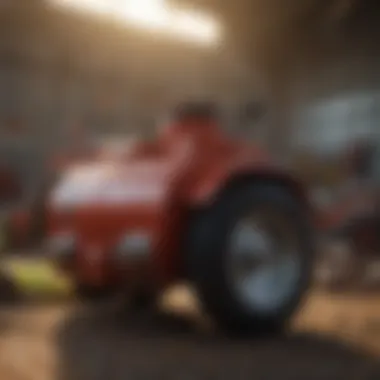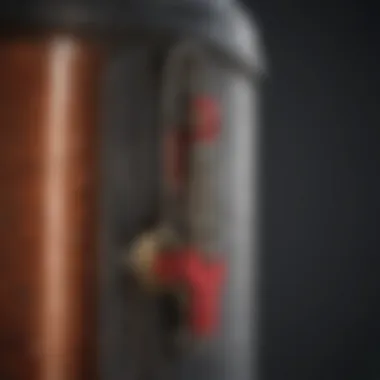Essential Spray Tank Accessories for Optimal Performance


Intro
When it comes to effective agricultural spraying, understanding your spray tank and its accessories can truly make all the difference. This isn't just about attaching a nozzle and filling the tank. There's an entire ecosystem of accessories that can enhance efficiency, improve safety, and ensure that every drop counts. As such, a well-informed selection of accessories is paramount.
The heart of effective spraying lies in not just what you spray but how you spray it. Accessories play a critical role in this process. They can range from simple additions like strainers to more complex tools such as flow meters and pressure gauges. Each component serves a unique purpose and has a direct impact on the overall performance of your spraying operations.
This guide will take you through key concepts, current trends, practical applications, and all the essential information concerning spray tank accessories. Whether you're a seasoned pro or someone just starting with agricultural spraying, this comprehensive overview aims to equip you with the knowledge to optimize your equipment for better outcomes.
As we navigate through this landscape of equipment, we'll dive into technical terms and latest trends, demystifying the world of spray accessories so that you're not left in the dust. It's time to get down to the nitty-gritty and see how these accessories can work together to maximize not just efficiency but also safety during agricultural practices.
Understanding Spray Tanks
Spray tanks serve as the backbone of modern agricultural practices. Understanding these tanks not only helps in the effective application of chemicals but also ensures efficiency and safety in farming operations. In recent years, as agricultural demands have grown, so has the complexity of spray systems. Knowing how these tanks function is crucial for any farmer or enthusiast looking to optimize their spraying practices.
One of the paramount aspects of spray tanks is their capacity. They vary widely, accommodating different farming sizes and needs. A small organic farm might require a tank of just a few gallons, while expansive commercial farms utilize tanks that hold hundreds of gallons. This variation means that choosing the right tank size is essential to avoid unnecessary refills and wasted time, contributing to a more fluid operational process.
Furthermore, maintaining an understanding of spray tank configuration, including pumps, nozzles, and pressure systems, is equally important. These components work together to ensure an even and consistent application of pesticides and fertilizers. Understanding these can impact crop health significantly. For instance, improper nozzle choices can lead to uneven coverage, resulting in under or over-application of chemicals that can pose threats to crop yields and environmental health.
Choosing the right spray tank also involves considerations like the type of crops being treated and the chemicals being used. Certain plants may require specific application rates or methods, thus influencing tank selection. Hence, understanding spray tanks is not merely about knowing their capacities but grasping how they interact with farming practices to promote effective agricultural management.
"A well-chosen spray tank is like a reliable partner on the field—it gets the job done efficiently and safely."
In summary, grasping the essentials behind spray tanks empowers farmers and enthusiasts alike to make better-informed decisions—ultimately enhancing the productivity and effectiveness of agricultural practices.
Essential Accessories for Spray Tanks
When it comes to optimizing the performance of spray tanks, the right accessories play a critical role. These essential components not only enhance efficiency but also ensure safety and precision in agricultural applications. Understanding each accessory's unique function and benefits can bolster overall spraying operations, allowing farmers to achieve their desired results with fewer resources and reduced risks.
Spray Nozzles
Types of Nozzles
Spray nozzles come in a variety of shapes and sizes, each designed to serve specific spraying needs. The most common types include flat fan nozzles, conical nozzles, and hollow cone nozzles.
- Flat Fan Nozzles: Best suited for applying chemicals over broad areas. They deliver a uniform distribution which is handy when targeting plants that require even spraying.
- Conical Nozzles: Great for targeting plants with height variations, directing chemical flows in a way that minimizes drift.
- Hollow Cone Nozzles: Often used for pesticide applications, these nozzles produce a fan-shaped spray pattern essential for ensuring thorough coverage.
Each type brings its unique advantage, whether it’s in terms of coverage, efficiency, or drift control, making their selection vital based on the specific tasks at hand.
Nozzle Selection Criteria
Choosing the right nozzle involves more than just picking the sleekest-looking option. Key selection criteria include:
- Application Type: Different tasks require different spray patterns.
- Chemical Properties: Pesticides and fertilizers behave differently; matching these with the right nozzle can yield optimal results.
- Pressure and Flow Rate: Each nozzle has specific pressure ratings that dictate the flow rate and pattern, and understanding these metrics is essential.As each factor can greatly influence the success of an application, careful consideration is paramount.
Maintenance of Spray Nozzles
To keep nozzles functioning optimally, maintenance cannot be overlooked. Common practices include:
- Regular Inspection: Checking for clogs or wear and tear prevents malfunction during applications.
- Cleaning: Using clean water or a specialized cleaning solution keeps nozzles free from preventable blockages.
- Calibration: Ensuring nozzles are correctly calibrated aids in achieving the desired application rates.
By staying ahead of maintenance, farmers can avoid costly downtime during critical application periods, safeguarding both performance and investment.
Filters
Importance of Filtering
Filtering is crucial because encapsulated debris and impurities can wreak havoc on system efficiency. Proper filtering protects pumps and nozzles from damage and ensures that chemicals are applied uniformly without interruption. In this sense, filters act as the gatekeepers of spray systems, extending their lifespan and boosting their effectiveness.
Types of Filters
Within filtering systems, options abound, each serving distinct functions:
- Screen Filters: Great for removing larger particles, easy to clean and maintain.
- Disc Filters: Offers a significant surface area for optimal filtration, particularly beneficial for those dealing with finely ground chemicals.
- Media Filters: Often used in higher-end applications, these filters provide extensive filtration even for small debris, ensuring clear flow.
Choosing the right filter is paramount to keeping your spray system running efficiently and preventing unwarranted interruptions.
Filter Maintenance
Much like nozzles, maintenance of filters is integral to system health. This includes reviewing the condition of:
- Filter housings: Ensure they are securely attached and not leaking.
- Cleaning intervals: Establish a routine cleaning schedule based on the type of chemicals used and environmental conditions.
- Replacement timelines: Keep an eye on wear signs; waiting too long can lead to system outages.
Hoses and Connectors
Material Considerations


Selecting the right materials for hoses and connectors can significantly impact durability and flexibility:
- Polyurethane: Known for its toughness and resistance to abrasion, perfect for farmers who need long-lasting hoses.
- PVC: Light and cost-effective but may wear out quicker in harsher conditions.
- Rubber: Excellent for high-pressure systems but tends to be heavier and more expensive.
Each material fits different needs, and understanding these will help ensure you are not cutting corners in application efficiency.
Connector Types
The choice of connectors also carries weight. The common types:
- Camlock Connectors: Easy to use, facilitating rapid connect and disconnect.
- Threaded Connectors: More secure but require screwing and unscrewing, which can take extra time.
- Barb Connectors: Simple and often used for more basic setups, but they can become loose over time without careful monitoring.
Choosing the right connector enhances durability and prevents leaks, which can lead to costly waste during operations.
Hose Maintenance Tips
Proper care of hoses extends their life:
- Inspect for leaks regularly. Any sign of wear prompts immediate attention.
- Store properly to avoid kinks and ensure smooth functioning.
- Flush hoses post-use to prevent chemical buildup, safeguarding future applications.
Pumps
Pumping Mechanisms
Understanding the type of pumping mechanism in use is crucial for efficiency:
- Positive Displacement Pumps: Excellent for high-pressure applications, they provide consistent flow.
- Centrifugal Pumps: Great for lower-pressure tasks, they're often easier to maintain and handle larger volumes at lower pressures.
The right pump mechanism can mean the difference between smooth operation and frustrating downtime.
Performance Ratings
Performance ratings give a peek into how well a pump can handle specific tasks:
- Flow Rate: Measured in gallons per minute, it determines how much chemical can be applied at once.
- Pressure Rating: Essential for knowing what your system can handle without bursting or breaking down.
Understanding these ratings helps make informed decisions when selecting pumps.
Pumps and Energy Efficiency
In an era where energy conservation is paramount, choosing pumps designed for energy efficiency makes sense:
- Variable Speed Pumps: Offer energy savings as they adjust flow based on requirement, preventing waste.
- Energy Star Rated Pumps: These models meet high efficiency standards, reducing energy costs in the long run.
Choosing energy-efficient pumps is not just smart fiscally but environmentally conscious, offering a dual benefit in application practices.
Pressure Gauges
Purpose of Pressure Gauges
Pressure gauges serve a pivotal function in maintaining safety and efficacy. They:
- Provide real-time feedback on system pressure, ensuring optimal performance.
- Alert users to potential malfunctions before they escalate into hazardous situations.
Maintaining accurate pressure in spray systems can prevent leaks and equipment failure.
Types of Gauges
There are several types of pressure gauges to consider:
- Analog Gauges: Simple and reliable but require regular checks for accuracy.
- Digital Gauges: Offer precise readings and often have alarms for excessive pressure, making them favorable for most modern setups.
- Liquid-Filled Gauges: Generally used in high-vibration environments as the liquid dampens the needle movement, providing stable readings.
Selecting the right gauge can keep operations running smoothly.
Calibration and Accuracy
Regular calibration of pressure gauges ensures accuracy:
- Routine Checks: Set intervals for checking gauge performance keep systems running as intended.
- Replacement Guidelines: Knowing when to replace aging gauges can save time and prevent measurement errors.
Proper calibration and timely replacements sustain accurate performance patterns, essential for optimal spraying operations.
Metering Devices
Types of Metering Devices
In the realm of agricultural spraying, a few types stand out:


- Flow Meters: Measure the volume of liquid passing through, crucial for maintaining chemical application rates.
- Piston Pumps: Offer precise metering and are often used for chemicals where exact dosages are necessary.
Each type's unique application lends itself to enhancing overall efficiency during spraying.
Importance in Chemical Application
The role these devices play is paramount:
- They ensure precise quantities of chemicals are dispensed, reducing wastage.
- Maintain environmental safety by preventing over-application, which can lead to contamination.
By investing in accurate metering devices, farmers can adhere to best practices in chemical application.
Installation Considerations
Properly installing metering devices retains their accuracy and reliability:
- Follow manufacturer guidelines closely to avoid issues.
- Ensure there are no air leaks in the system which could distort flow readings.
Taking the time to install correctly pays off with continued accuracy and stronger performance over time.
Agitation Systems
Functionality of Agitation
Agitation systems are necessary to keep chemicals mixed and uniformly distributed:
- Homogeneity is essential for applications, preventing sedimentation or layering, which can lead to uneven distribution in spraying.
Without adequate agitation, users risk ineffective applications, potentially compromising yield and crop health.
Types of Agitation Systems
Various types serve specific needs:
- Mechanical Agitation: Uses impellers to mix liquids, ideal for large volumes.
- Air-Driven Agitation: Uses compressed air to circulate products and is quieter.
Selecting the right type simplifies operations and enhances efficiency.
Agitation Maintenance
Keeping agitating systems well-maintained is vital:
- Regular Checks: Ensure moving parts are functioning free of obstructions.
- Lubrication: Necessary for mechanical systems to sustain smooth operation over time.
With thorough inspections and proactive maintenance, longevity and effectiveness are significantly improved.
Backflow Preventers
Importance of Backflow Prevention
Backflow preventers serve a vital purpose within chemical spraying systems:
- They safeguard against the contamination of potable water due to back-siphoning, maintaining compliance with safety standards.
In terms of preventing environmental harm, these devices prove indispensable as well.
Types of Backflow Preventers
Choosing the right type is essential:
- Reduced Pressure Zone Devices: Highly effective for high-risk applications.
- Double Check Valves: Useful in less critical conditions, still offering solid protection.
Consideration of the environment and application risk factors is crucial.
Installation Guidelines
Proper installation techniques bolster the effectiveness of backflow preventers:
- Follow Best Practices: Always adhere to local regulations and standards.
- Regular Testing: Schedule functional tests to ensure consistent performance and safety over time.
By integrating preventative measures correctly, users can maintain a safe and efficient spraying environment.
Benefits of Utilizing Spray Tank Accessories
Utilizing accessories for spray tanks goes beyond just adding bells and whistles to the equipment. It’s about significantly enhancing the performance and effectiveness of agricultural spraying operations. Here, we delve into the key advantages of employing these accessories, touching on how they contribute to efficiency, safety, and overall cost-effectiveness.
Enhanced Efficiency


When it comes to agricultural practices, every drop counts. Accessories like spray nozzles tailored to specific tasks can vastly improve the application of chemicals. For instance, a fan nozzle might distribute liquid over a wide area, while a cone nozzle would focus on delivering a concentrated stream. The choice of accessory can lead to an optimal coverage, ensuring that no patch of land is left untreated.
- Precision in Application: The ability to apply precisely where needed allows farmers to use fewer chemicals, thus achieving better results without wastage. The right nozzle can reduce drift and increase uniformity in coverage.
- Time Savings: Efficient spraying means completing jobs faster. Accessories can help boost the speed of application, allowing farmers to cover more ground in a shorter amount of time.
- Automation Features: Modern accessories can include advanced technologies such as automatic pressure regulation that keeps spray patterns consistent, freeing farmers to focus on other vital tasks.
In short, adopting advanced accessories is like having a secret weapon in the quest for productivity, leading not just to better fields but also to an improved bottom line.
Improved Safety
Safety is a paramount concern in agricultural spraying. The type of accessories chosen is crucial in minimizing risks associated with chemical applications. One such accessory, the backflow preventer, plays a pivotal role in ensuring that no chemicals contaminate water supplies.
- Protecting Water Sources: Backflow preventers block the reverse flow of potentially hazardous liquids, safeguarding groundwater and drinking water resources.
- Worker Protection: Accessories like personal protective equipment-specific sprayers can help ensure that operators are not exposed to harmful substances during application. Equipment designed with ease of use in mind minimizes the likelihood of accidents in the field.
As the saying goes, "an ounce of prevention is worth a pound of cure." Investing in the right accessories for increased safety can mean safeguarding not just the environment, but also the health of those who work in the fields.
Cost-Effectiveness
While it might seem that purchasing additional accessories involves an upfront investment, the long-term savings can be substantial. Accessories enhance performance and longevity, which translates into monetary benefits.
- Reduced Consumption of Chemicals: By maximizing efficiency through proper accessories, farmers can reduce their chemical costs. This means less spent on pesticides and herbicides with higher efficacy.
- Extended Equipment Life: High-quality accessories can help maintain the main tank and its components. For instance, using the right filters can prevent clogging and degradation of pumps, thereby extending their lifespan.
- Decreased Downtime: Efficient and well-maintained accessories can reduce the frequency of repairs or replacements, meaning farmers can focus on cultivation rather than equipment issues.
Investing in quality spray tank accessories is not just a smart move; it’s an essential strategy for farmers looking to enhance productivity and sustainability.
Maintenance of Spray Tank Accessories
Maintaining spray tank accessories is not just a box to tick; it’s a necessity for smooth operations and longevity of the equipment. Each part works in concert to enhance performance and efficiency, meaning that when one piece falters, it can send shockwaves through the whole system. From improving safety to ensuring cost-effectiveness, a solid maintenance routine is your best bet in maximizing returns on your agricultural investments.
Regular Inspection Practices
Regular inspections are the backbone of any maintenance routine. Think of it as giving your spray tank and its accessories a thorough check-up — and just like with people, catching issues early can avoid major headaches down the road. Inspect components like hoses, connectors, and nozzles regularly. Look for wear, leaks, or blockages, as even the smallest problem can escalate quickly.
Some savvy agronomists keep a checklist, going through each accessory systematically:
- Hoses: Check for cracks or signs of wear.
- Nozzles: Ensure they are not clogged and are functioning correctly.
- Filters: Inspect them for dirt and buildup, as this can hinder performance.
If it seems like a cumbersome task, remember that neglect can lead to much bigger problems like equipment failure, increased repairs cost, or even safety issues, which none of us want.
Cleaning Protocols
Proper cleaning schedules should not be an afterthought; they should be part of your daily operations. After all, dirty equipment can lead to ineffective spraying and wasted resources. Many farmers know the pain of a blocked nozzle: it’s like trying to drink through a straw with a hole in it!
To maintain optimal condition, consider these protocols:
- Post-Use Clean: Rinse equipment after every use to remove residues of chemicals and dirt. Leaving these substances to sit can cause corrosion or buildup.
- Deep Clean: At least once a season, give your accessories a thorough deep clean. Use compatible, non-corrosive cleaners to avoid damaging parts.
- Drying: Ensure everything is dry before storage to prevent rust or mold in moist environments.
By incorporating these cleaning habits, you can prolong the life of your spray tank and accessories while maintaining peak performance.
Replacement Guidelines
Eventually, like all good things, accessories reach the end of their lifespan. Knowing when to replace components is a fine art that can save you a lot of trouble. It’s not all about waiting until something fails; rather, proactive replacement can be a wise strategy to ensure seamless operation.
Here’s a simple guide:
- Age and Usage: Different parts have different life expectancies based on the frequency of use and exposure to elements.
- Inspection Outcomes: If regular inspections reveal significant wear—like frayed hoses or heavily corroded connectors—it’s time to seriously consider replacements.
- Manufacturer Recommendations: Always check with manufacturer guidelines on replacement intervals. Some might suggest replacing nozzles after a specific number of gallons sprayed.
"An ounce of prevention is worth a pound of cure." Regularly reviewing your components means you can catch and replace them before they create bigger headaches.
Future Innovations in Spray Technology
The realm of spray technology has witnessed leaps and bounds, especially in recent years. This section aims to explore the future innovations that are shaping this industry, focusing on smart accessories and more sustainable options. Both elements serve not only to enhance efficiency but also address the growing concern for environmental impact in agriculture. As farmers and enthusiasts step into an era that prioritizes precision and sustainability, understanding these advancements becomes paramount.
Smart Accessories
Smart accessories in spray technology bring a dose of intelligence to the field. These devices are equipped with sensors and connectivity features that allow real-time data collection and analysis. For instance, a smart spray nozzle can adjust its output based on environmental factors like wind speed and humidity. This kind of responsiveness ensures that each droplet lands exactly where it needs to, minimizing waste and optimizing chemical application.
Another game-changer is the integration of GPS technology. Farmers utilizing drones equipped with smart equipment can survey fields efficiently, identifying areas that might need more attention. The resulting data allows for precision targeting, reducing overall usage of chemicals and minimizing the ecological footprint.
Incorporating smart accessories can also streamline the spraying process. Imagine an automatic calibration feature that adjusts settings based on pre-defined parameters. This leads to time savings and a reduction in human error—any agri-entrepreneur would recognize its value.
Furthermore, the benefits extend to maintenance. Many modern accessories come with diagnostic capabilities. They can alert you to potential issues before they become significant problems, thereby extending the lifespan of your equipment. Investing in smart technology is an investment in future profitability and sustainability.
"The intersection of technology and agriculture has the potential to redefine how we spray crops, making operations more efficient and ecologically responsible."
Sustainable Options
The emphasis on sustainability is not just a trend; it’s becoming a necessity. With increasing scrutiny on farming practices, the demand for sustainable spray solutions is higher than ever. Farmers are looking towards accessories that not only perform but do so while being mindful of their environmental impact.
Biodegradable chemicals and non-toxic formulations are at the forefront of this movement. Using such alternatives during spraying not only benefits the crops but also ensures that the surrounding ecosystem remains unharmed. In addition, there is an increasing interest in using renewable resources in the manufacturing of spray tank accessories themselves.
Moreover, manufacturers are focusing on innovative energy-efficient pumps and motors that consume less power while delivering optimal performance. This efficiency is vital in reducing operational costs over time. Coupled with smart accessories, these pumps can further adapt their energy use to the specific needs of the task at hand.
As regulations tighten and consumer awareness increases, adopting more sustainable practices isn’t just about compliance; it’s about staying competitive in the market. Sustainable options not only enhance the public image of farming operations, but they can also lead to reduced costs in the long run.
In summary, future innovations in spray technology are heading toward a more intelligent and eco-friendly direction. Incorporating smart accessories allows for precision and efficiency, while sustainable options address the pressing need for environmentally responsible practices. This dual approach promises not just a brighter future for agriculture but also a healthier planet.







